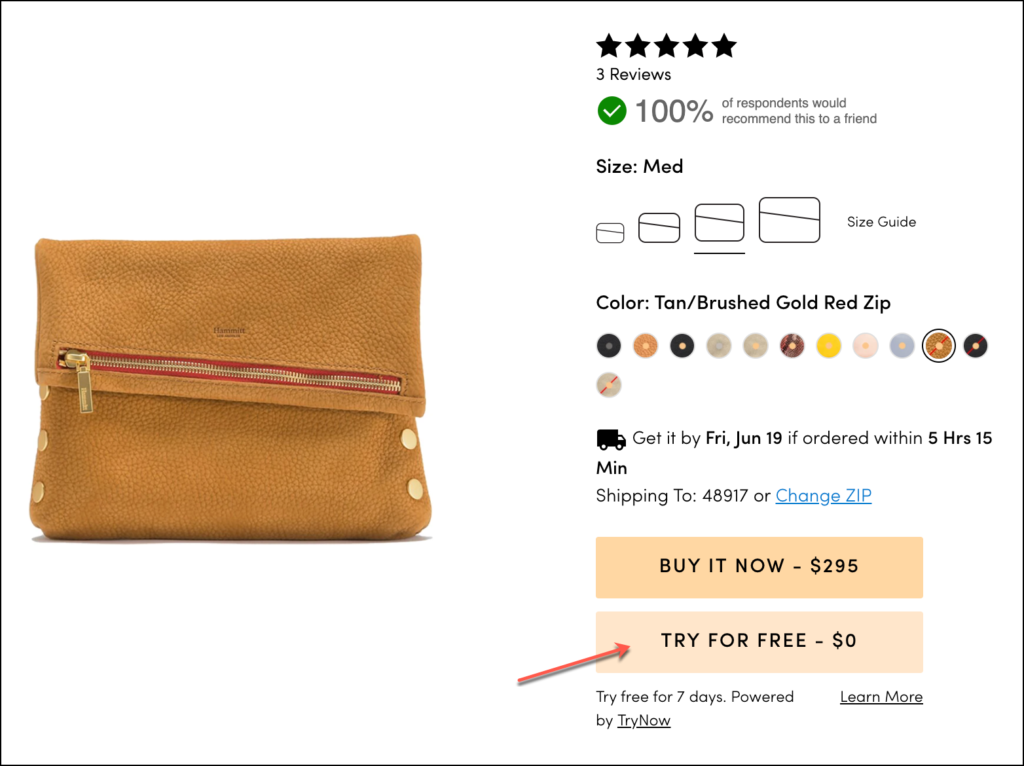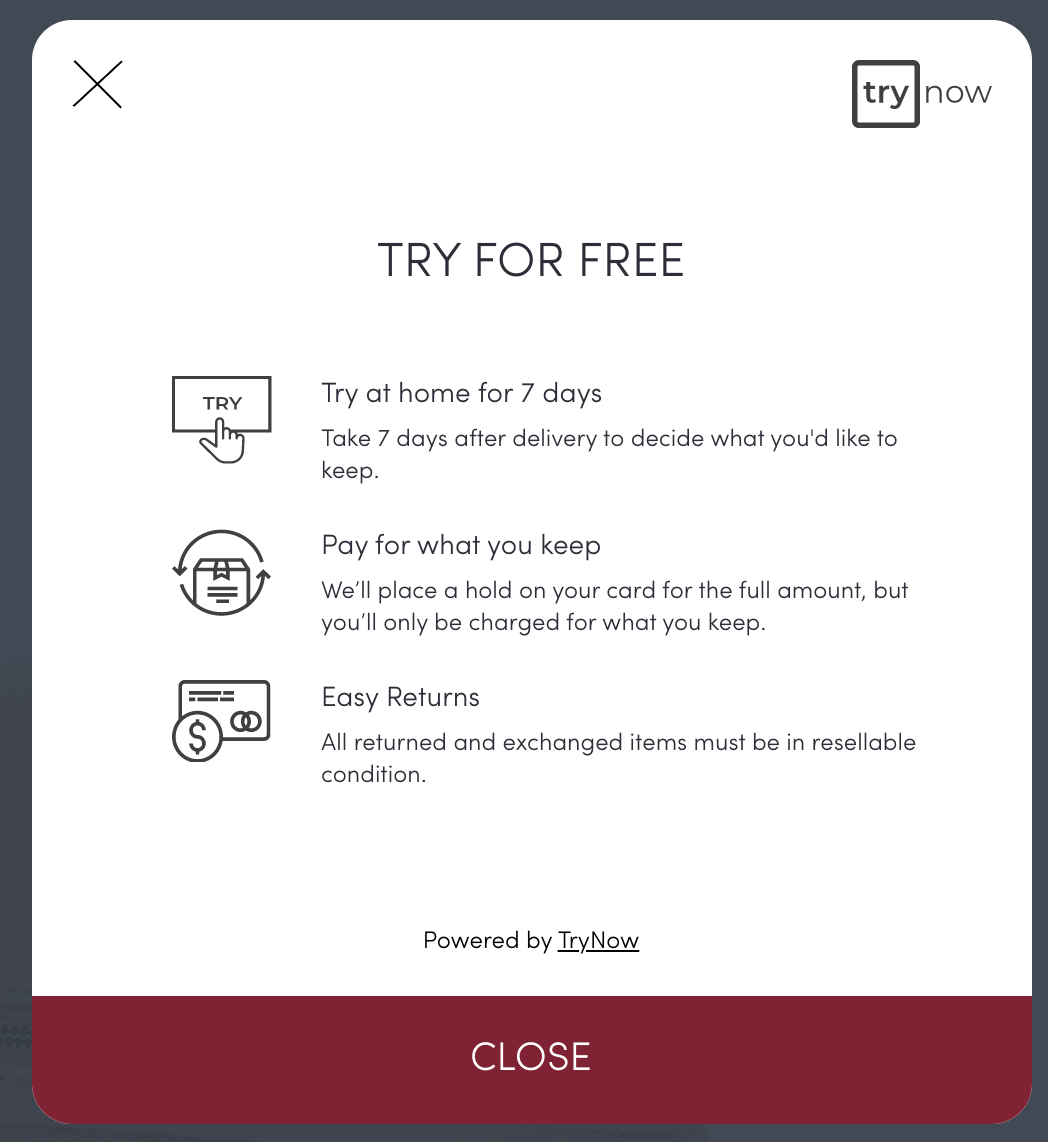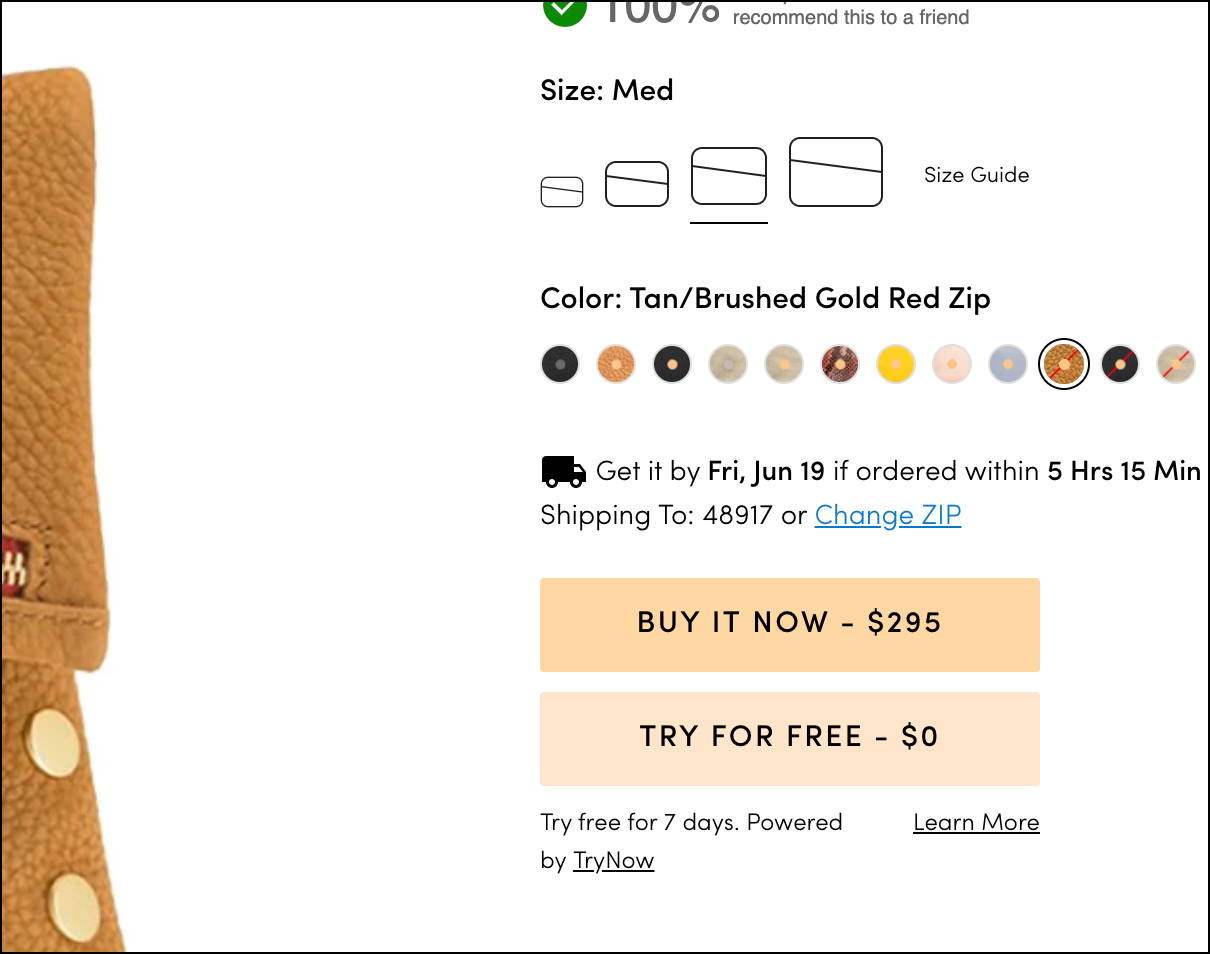Blog
My Review of TryNow
Marketers have been working for decades to reduce shopping friction:
- We’ve tried free shipping
- We’ve tried PayPal/Amazon checkout so shoppers don’t have a create a new account
- We’re tried free returns
- We’ve implemented services like Klarna and Affirm to break large payments into smaller chunks
I’ve seen something new. It’s a service called TryNow. The way it works is this: they add a TRY FOR FREE – $0 button right below your ADD TO CART button.
My TryNow Review
The idea
Converting the living room into the fitting room reduces friction. Your shoppers checkout for free and only pay for what they keep.
According to TryNow site, their service does the following:
- 22% higher conversion rates
- 63% higher average order values
- 76% higher return on advertising spend
Here is how the button looks:

Here is how they explain the service when “Learn More” is clicked in screenshot above (bottom right corner):

My prediction
In the short term
Novelty Effect will cause a significant boost. There is something about a button like TRY FOR FREE – $0 that’s impossible to ignore:

It short-circuits our brains. We expect to pay today, that’s how retail has always worked, seeing an alternate feels like a cheat code.
Long term
Reducing friction causes a lift in conversions. This is universal and not very shocking. But what marketers forget are the dangers of over-marketing.
What’s over-marketing? The job of a marketer is to drive awareness and gently nudge. When applied at a subtle level marketing is super powerful. But marketers don’t know how to do anything in moderation. We always go over and that’s when start backfiring. A great example, if you increase your email frequency 10% you’ll see a 10% lift. But keep on increasing frequency and one day you’ll end up losing your entire mailing list.
So, getting back to TryNow. In the long term, I am 100% confident this service will increase return rates. It’ll do one more thing: reduce buyer satisfaction.
You see, the magic of having a price-point is that it creates a buffer between discovery and purchase. It creates a little breathing room for the shopper. It allows them to get excited. In a restaurant here is a 15-minute gap between reading the dish description on the menu and seeing the item on your plate. That’s the romance of life.
We need to give the shopper time for their System 2 to be a little activated. Not full, maybe, but a little. Otherwise, when they receive the item their System 2 will be like, “God damn man, are you stupid?”.
TryNow Review Summary
This is an interesting concept. Long term, I’m not sure how things will play out.
Quick Question
Are you looking to purchase on a site that has TryNow option?
— or —
Are you looking to add TryNow to your online store?
Final frontier?
I know what you’re thinking, “if this TryNow service works there will be nothing to improve. After all, once you remove friction from buying what’s left?“
About Frictionless Commerce
We’ve been thinking about online buyer psychology for the last 11 years. Why do online shoppers behave the way they do? Does a product that is objectively better than the competition always win or does buyer perception matter most? We’ve learned some fascinating truths.




Comments 9
You do a great job of highlighting the things that many business owners may overlook. Yes, more product will fly off the shelves. It will also find its way back to the shelf more likely.
Question is, what will the percentage of products that get purchased from this experience? That will be the kicker for TryNow, especially if this is treated like a high-end solution. If it’s cheap to install and use, then I imagine it can be sticky and Shopify would be silly not to buy it. If it isn’t, the TryNow Team will need to quickly figure out how to make it cheap before the open source version appears.
ReplyRishi Rawat
I believe TryOut is in its nascency. Hard to predict if the idea will stick or not. But even if it does stick, I don’t like this trend to the bottom where retailers are eliminating *all* friction.
Remove friction if it improves the user experience, yes. But don’t train shoppers *not to pay*. Paying with a credit card is a good signal for if the shopper is series, and if the product is worth buying.
My fear is we’re following the silicon valley playbook where companies that have little underlying value, don’t even make money, get crazy high valuations. In the end, as with all illusions, they fail.
I like the Basecamp.com model. Make a great product (in their case, project management software), charge a fair price, end of the story.
Thanks for adding to the discussion, Hubert!
ReplyTell you what: Would you offer your services for $0 for a month? If the client is happy then they pay for it.
Maybe, something like that will work, you get results the first month, no risk to a client, and you win the contract for the long term.
But tell you what, during a global pandemic, what happens if I don’t like a product? Would, say, returning a wallet be bought by others? The one that I used and tried and didn’t like?
What are the unit economics for such a thing? Would more people just fiddle around and not make their mind for a product purchase? Would you risk long-term impact here?
I clearly hate this trend of deep discounting and offers, the big companies are fiddling with psychology and I don’t think in my right mind, that’ll yield good results for all.
Think about small-time players, they don’t have deep pockets to keep going at it.
As much as I like the concept, I think the CTR will be high. But, it’s a BIG BUT, I think long-term not a healthy move for the ecosystem.
ReplyRishi Rawat
I agree with your thesis. As always, you are 100% correct.
ReplyThis is an awesome idea Rishi!
I have seen similar ideas online. I think Warby Parker has a deal where they can send out 3 eye glass frames, (not sure if they charge, or put a hold on your credit card).
There is a jewelry website called https://www.experiencememo.com/ where they have a try it on at home deal.
I think this is a brilliant idea!
ReplyI should say this is an awesome idea for higher end products, that have low conversion rates – like expensive jewelry. Reduces fear I think. “Try it on, see if you like it, then pay us.”
ReplyRishi Rawat
Right. But does it have long term negative consequences? Like significantly higher returns?
ReplyI think the return rates point is the big question here. On the one hand, we know shoppers already do “bracketing” and worse “wardrobing”, which–at least for stores offering free shipping and returns–accomplishes the same (or worse) result as this feature, which is basically seller-sanctioned wardrobing/bracketing. So while I was initially skeptical about the economics, looking at it that way, it might actually work, and I bet there’s a loyalty boost for customers who are not purposely abusing it.
Also I must say great choice of example brand–the thing that would convert me is that absolutely stunning estimated delivery date section. Now that baby converts. :^)
ReplyRishi Rawat
Hi, Vince. I specifically picked the brand that would get your attention :). Their shipping estimate tool is beautiful.
Reply